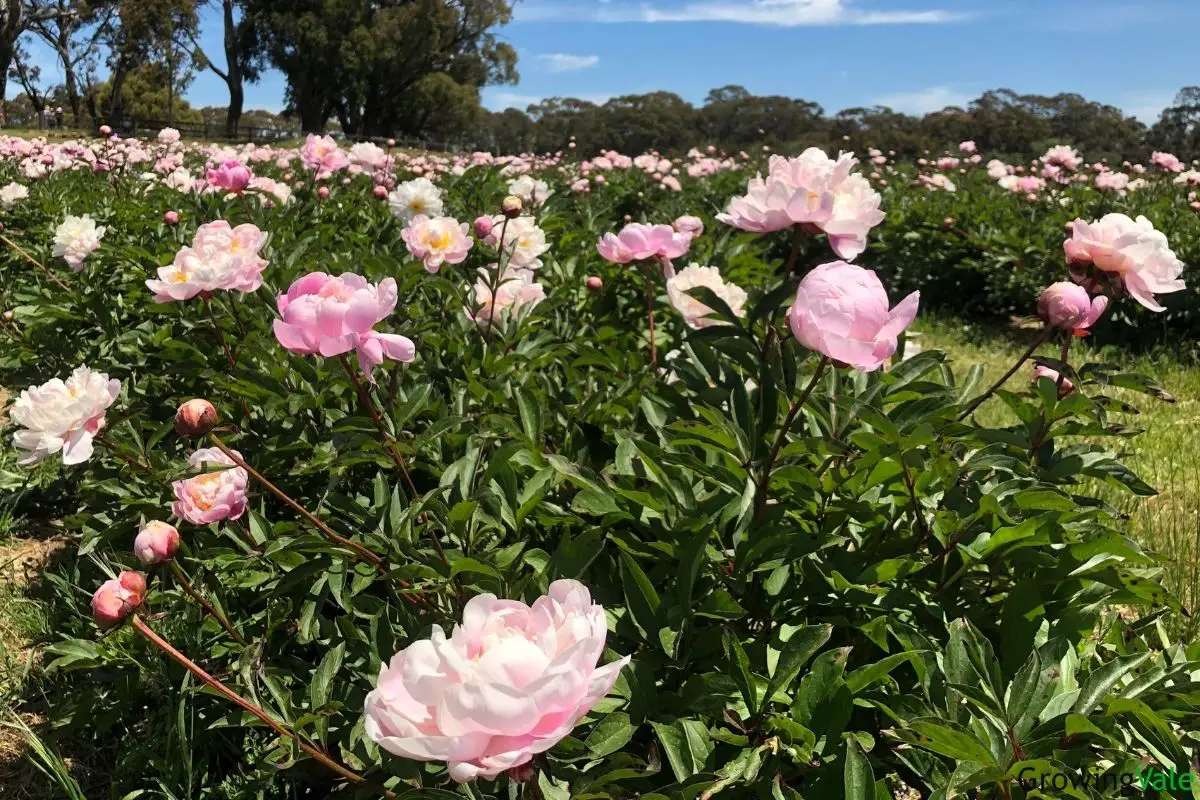A firm favorite in the hearts of gardeners everywhere, peonies are wonderful flowers that bring delight into the garden every year.
There are an estimated 40 species in the genus Paeonia consisting mostly of herbaceous perennials (herbaceous peonies), but also of woody shrubs (tree peonies), and hybrids of the two (Itoh peonies).
They are low-maintenance plants and extremely long-lived. With the right care, they can live to be 20-30 years old, but some peonies are recorded to be over 100 years old!
History
The Peony plant gets its name from Paeon, a disciple of the Greek god of medicine, Aesculapius. Legend has it that Paeon used a Peony concoction to treat Pluto who was injured during the Trojan War. Jealous of his healing skills, Aesculapius plotted to kill his disciple. However, Pluto learned of his plan and rescued Paeon by turning him into a Peony.
This is not the only legend to have surrounded the Peony. As far back as 300 B.C., stories were told of how Mars, the Greek god of war, disguised as a red woodpecker, would peck out the eyes of anyone foolish enough to uproot a Peony. These stories are thought to have been circulated by greedy herb collectors who sold peonies to physicians for medicine.
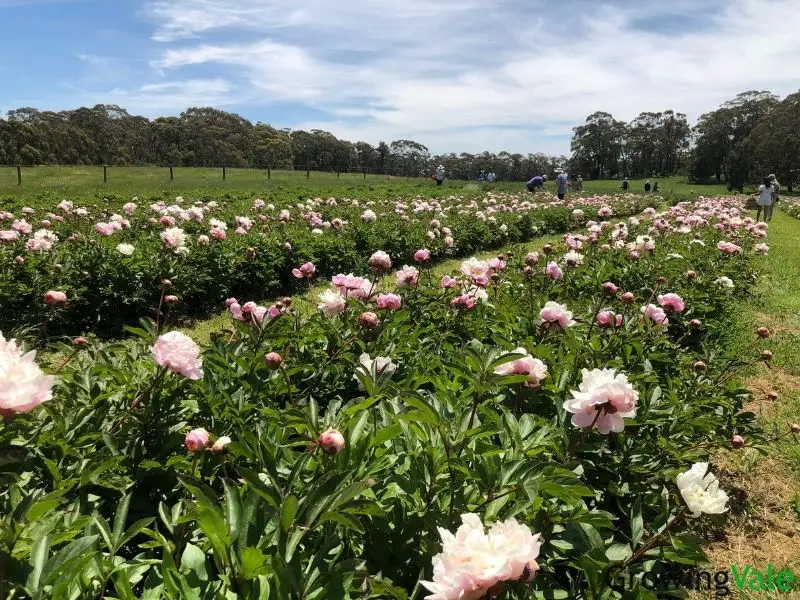
One of the earliest peonies to have reached Europe, P. officinalis, or the Common Peony, was introduced as early as 1548 to Britain. The garden favorite P. lactiflora followed from China over two centuries later. Following that, many cultivars and varieties were bred to feed the Peony frenzy which was sweeping the globe, and very much still is today.
Peony flowers come in many colors and forms, such as single, semi-double, fully double, Japanese, bomb, and anemone. Generally speaking, tree and Itoh peonies have larger flowers, with some tree peony blooms reaching up to 12 inches wide.
Plant Facts
| Scientific name | Paeonia spp. |
| Common names | Garden Peony, Herbaceous Peony, Intersectional Peony, Chinese Peony, Tree Peony, Common Peony |
| Genus | Paeonia |
| Family | Paeoniaceae |
| Height | 1.ft 6 in. – 6ft. 0 in. |
| Width | 1ft. 6 in. – 6ft. 0 in. |
| USDA Plant Hardiness Zone | 3a, 3b, 4a, 4b, 5a, 5b, 6a, 6b, 7a, 7b, 8a, 8b |
| Origin | Asia, Europe, North America |
| Flower colors | Red, Pink, Yellow, Orange, White, Cream, Purple |
| Blooming season | Mid-spring-early summer |
| Plant/Flower special features | Large, showy flowers |
How to Plant and Grow Peony Bulbs
Peony bulbs should be planted in fall so they can become established before the winter frost. When choosing a site take into account the levels of light and soil conditions.
They need to be in a sheltered site to protect them from strong winds, but away from trees or large shrubs. Aside from the shade cast by neighboring trees and shrubs, they do not like competing for nutrients or water.
Tree peony plants are usually purchased from nurseries in containers, they can either be full-fledged plants or bare roots and tubers. Plant them in April – November well before the first frost so the root system can get firmly established. They can tolerate being close to other trees and shrubs, but won’t thrive with too much shade.

Growing Peony Flowers in a Bed
Once a suitable site has been chosen, dig a hole deep enough to accommodate the root ball, and twice as wide. If needed, amend the soil with compost and well-rotted manure. Plant the peony bulbs with their red-eye bud 1 inch below the soil line.
Do not plant them any deeper than 1 inch as this will reduce flowering. Water well and continue to do so until plants are established. Space them at least 3 feet apart from each other, and at least 12 inches apart from other herbaceous plants.
Tree peonies bulbs should be planted with the rootstock well below ground level. Ensure the graft union (the small bulge at the base of the stem) is at least 6 inches below soil level to encourage root formation.
Herbaceous peonies will benefit from extra support to prevent their stems from bending under the weight of their flowers. Stake and ring them when shoots are small to prevent mechanical damage later on to new shoots.
Growing Peony Flowers in a Pot
Peonies can be grown in pots and should be planted in the same way as if they were in beds. Use a large, well-drained container, and keep an eye not to overwater them as they are susceptible to root rot. They are hardy and do not need to be overwintered.
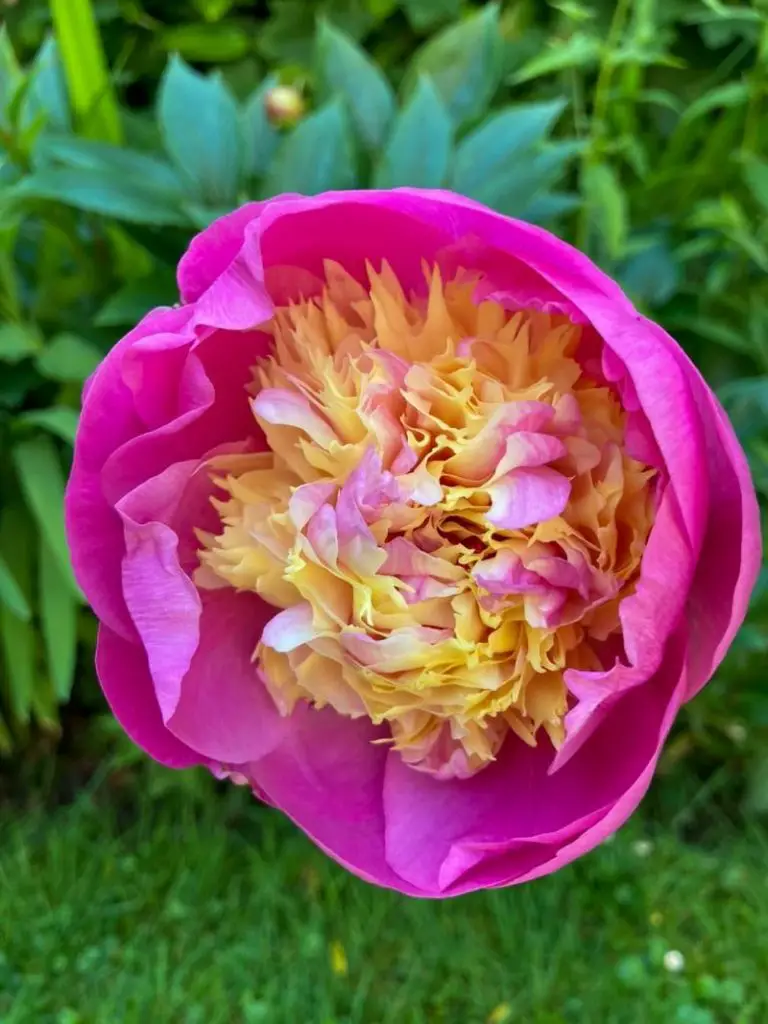
Propagation
Many popular Peony plants are hybrids so may not grow true to seed. For this reason, propagation by division is the most widely used method. However, propagation from seed is easy and possible.
Commercially, tree peonies are propagated by grafting, but this is a labor-intensive process and not recommended at home due to low success rates. A more recommended method is layering.
Division
Propagate these plants by division in the fall (late September – early October) after the foliage has been cut back down to ground level. Tree peonies don’t need to be cut back, however, they should also be divided in fall. Make sure to plant new divisions before the ground freezes to allow roots to acclimate to their new surroundings.
Using a spade, lift the plant as gently as possible out from the ground, making sure to keep the delicate root system intact. Wash off or use hands to remove any remaining soil surrounding the roots to expose them and any new forming buds.
Using a sharp knife, divide the crown into sections, each with at least 3 new growth buds and some roots. Plant sections back into the ground making sure red-eyes are a maximum of 1 inch below the surface.
Tree peonies don’t have eyes but should be divided by stems in the same manner. This is a simple process for multi-stemmed varieties but not possible for single stem varieties.
Many plants may grow for up to 15-20 years before they need dividing, and it is important not to divide plants younger than 3 years as this may negatively affect growth. Expect flowering 2 years after division.
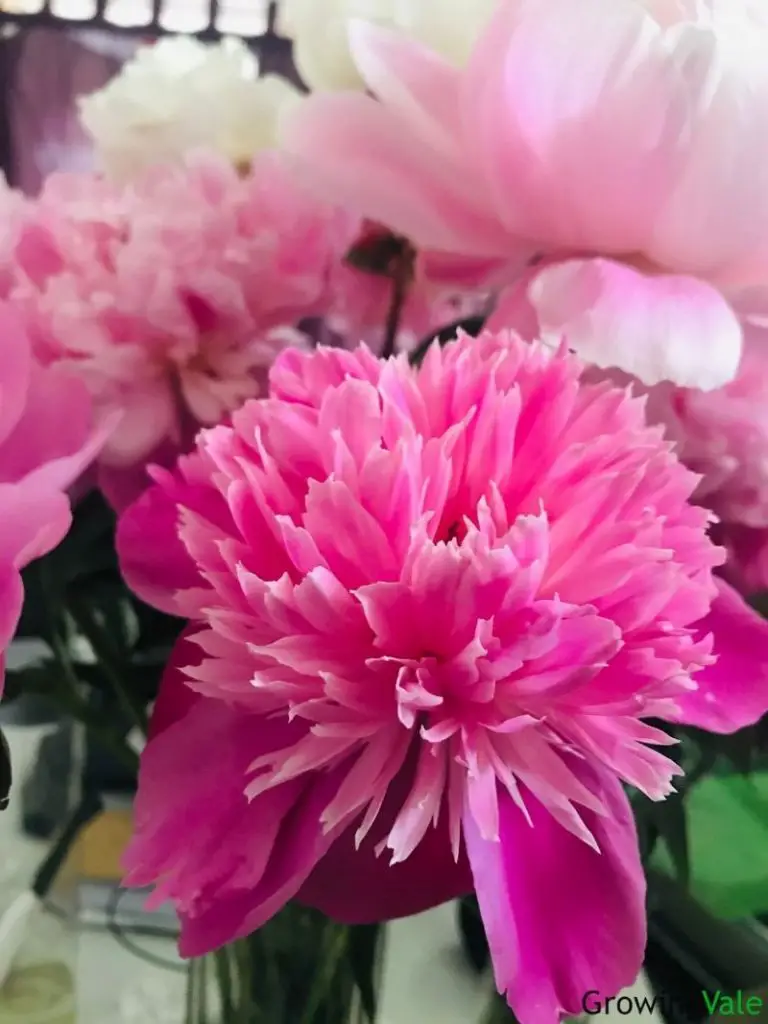
Seeding
Collect your seeds from ripe seed pods which are beginning to split in late summer to fall, or purchase them. Harvested seeds may be black or red, discard any red seeds as these have not been fertilized and will not germinate.
Sow your newly harvested seeds 1 inch deep in a tray with seed compost, and place either in a cold frame or a sheltered spot outdoors such as next to a wall or fence. Ensure that the compost stays moist.
Seedlings will take up to 5 years before they reach blooming size. Bear in mind that Peony seeds are double dormant, meaning that seeds need to be exposed to two cold periods with a warm period in between. This means that roots will grow in spring after the first cold period, and leaves and stems will only emerge after the second cold period.
Layering
To propagate through layering, make sure to pick young shoots which are flexible enough to bend over. The layering of tree peonies can be undertaken in either spring or fall. It should take around 2-3 years before the root system is strong enough for the branch to be severed from the parent plant.
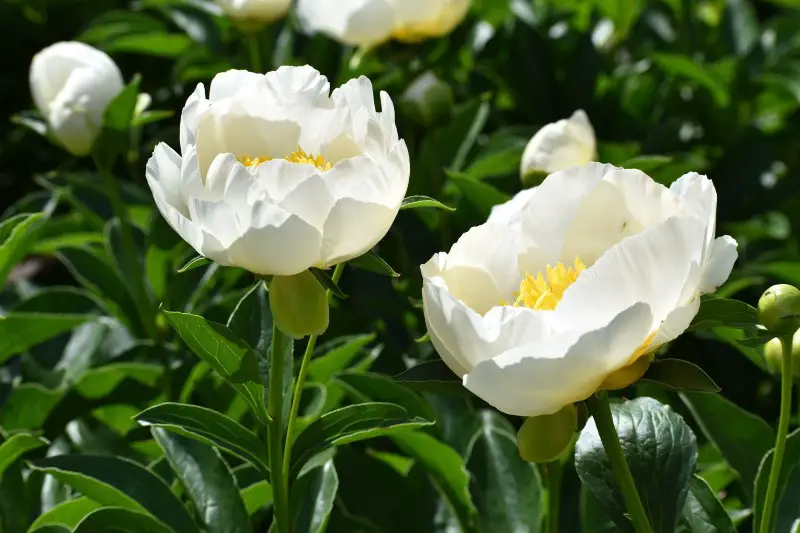
Peony Care and Maintenance
Soil
Peonies will grow well in a range of soil types, provided the soil doesn’t become water-logged or overly dry. However, they prefer a well-draining, fertile, and slightly acidic soil. Before planting in the fall, mix in compost or well-rotted manure about 1 foot deep. A small amount of bone meal can also be incorporated if needed.
Tree peonies prefer well-draining, fertile, and slightly alkaline soils. They also benefit from iron in the soil which helps deepen flower color. Application of iron sulfate is recommended.
Water
The peony bush is relatively low-maintenance. Well-established plants will have a deep root system so will not require routine watering. They should only be watered regularly in the first year during establishment and dry periods.
Allow the soil to dry out fully between waterings as they will not tolerate waterlogged conditions. When watering, wet the soil thoroughly to a depth of around 12-18 inches.
Fertilizer
To promote growth and flower production, fertilize peonies first in the spring, and then again shortly after flowering is finished. Use a general-purpose fertilizer at 20oz per square yard, and apply around the crown of the plant.
Take care not to apply too close to the crown (6-12 inches away should be fine), as crowns and new shoots are susceptible to fertilizer burn and could be damaged.
Finish by applying a layer of mulch (compost or well-rotted manure) to repress weeds and conserve moisture. Again, avoid putting mulch too close to the crown as this could cause harm.
Once every few years, add a handful of bone meal around the plant and gently mix into the surface of the soil. The use of Nitrogen-based fertilizers is not recommended as this tends to result in spindly foliage and fewer blooms.
Sunlight
Peonies should be grown in full sunlight, with a minimum of 6 hours of direct sun a day. Peony flowers perform best in sunny spots, and plants grown in shaded areas will produce fewer blooms.
Tree peony flowers are more fragile, and in hotter climates may benefit from protection during the hottest part of the afternoon. In some Asian countries, parasols are used to shield and protect flowers from the midday sun.
Temperature and Humidity
Peony flowers are hardy to USDA zones 3-8 and prefer a cooler climate. A period of winter chill is required for them to bloom to their full potential. Space them apart to allow sufficient airflow between plants to prevent diseases such as powdery mildew.
Pest and diseases
In optimum conditions, these plants are generally trouble-free, however, they are susceptible to some pests and diseases. Diseases include powdery mildew, Peony wilt, Peony blotch, and blight.
Peony wilt is one of the most serious of these diseases and causes wilting and dieback of foliage and flowers. If found, remove all infected parts and burn them safely to prevent spore production.
Peonies can be affected by two types of blight, Botrytis (a black-brown rot on stems and leaves) and Phytophthora (which will cause the entire stem to turn black and die).
In the case of Botrytis, remove and destroy infected foliage and apply an appropriate fungicide. Phytophthora is more serious and requires the removal and destruction of the entire plant and surrounding soils.
Pests that affect these plants are Thrips and ants. While the ants may be mildly annoying, they cause no harm to the plant. Foliage infested with Thrips should be removed and destroyed.
Pruning
Peonies will die back every fall, during this time it is recommended to cut down foliage to the ground to reduce the risk of Peony wilt disease.
Some gardeners like to disbud their plants, this involves the removal of side buds often found on stems. Removal allows the plant to focus more energy and resources onto the central flower and produces a bigger and better bloom. Buds should be removed as soon as they are spotted. Remove spent flowers as they wither.
Tree peonies do not need to be cut back to the ground in fall, but like most woody shrubs would benefit from pruning to maintain health and form after flowering.
Toxicity
All parts of the plant are mildly toxic to people and animals if ingested. Symptoms of poisoning include nausea, diarrhea, and vomiting.

Uses of the Peony Bush
Peonies are hugely popular ornamental plants with festivals and competitions held every year for gardeners to showcase their beauty. They are also great choices for cut flowers, and herbaceous peonies such as Paeonia lactiflora are a particular favorite for wedding bouquets.
P. lactiflora has been cultivated in China for over a millennium and has been used as a traditional medicine for over 1200 years in China, Japan, and Korea to treat ailments such as fevers, rheumatoid arthritis, and muscle cramping and spasms. They were also used by the Ancient Greeks for similar purposes.
Common Varieties and Cultivars
Peonies come in a variety of beautiful forms and colors. Most have similar care and maintenance needs but may have slightly different bloom times. Having a range of varieties and cultivars in the garden not only looks lovely but with careful planning, can extend your blooming season by up to 6 weeks!
Below are some popular peony varieties and cultivars:
- Paeonia ‘Duchess Of Kent’ – bright pink, fully double flowers which develop a violet hue as they mature.
- Paeonia ‘Kopper Kettle’ – an Itoh Peony with fragrant, fully double, copper pink flowers which mature to soft gold with a central maroon flare.
- Paeonia ‘Morning Lilac’ – semi-double, deep purple flowers with occasional white and dark pink streaks. The color deepens closer to the center where the stamens have dark pink bases and yellow tips.
- P. lactiflora “Sarah Bernhardt” – fragrant, rose pink, fully double flowers occasionally flecked with deep pink.
- P. officinalis “Anemoniflora Rosea” – an anemone form flower with deep rose-pink guard petals and ribbon-like petaloids. Petaloids are deep rose-pink edged with yellow.
Conclusion
Peonies are long-lived plants with beautiful flowers which will return year after year. They fall under three main categories, herbaceous, Itoh, and tree, all of which generally have similar care needs. They are low maintenance and easy to propagate by division, making them the perfect addition to any garden.
Cultivated in China for over a millennium, P. lactiflora was used for medicinal purposes for over 1200 years in East Asia. Cultivation exploded following their introduction into Europe, where many cultivars and varieties have been bred since.
They are popular favorites for cut flowers and bouquets, and with so many forms and varieties to choose from, it is no surprise that dedicated festivals and competitions are celebrating their beauty.

